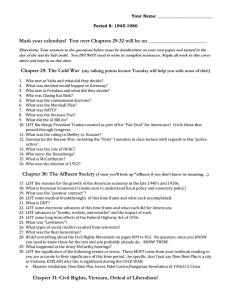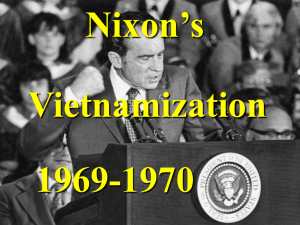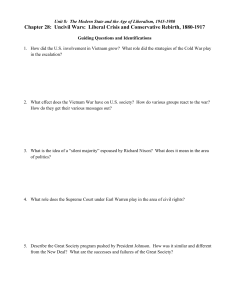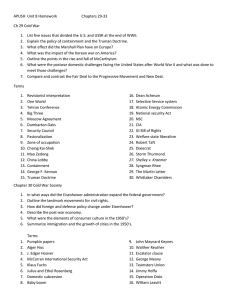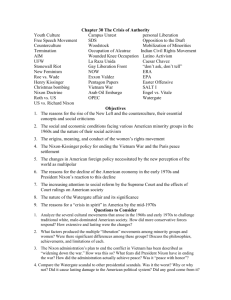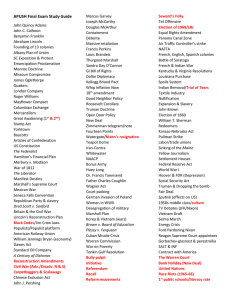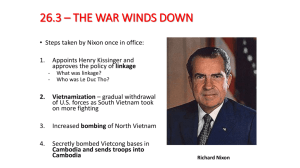The Vietnam War, 1965-1975
advertisement
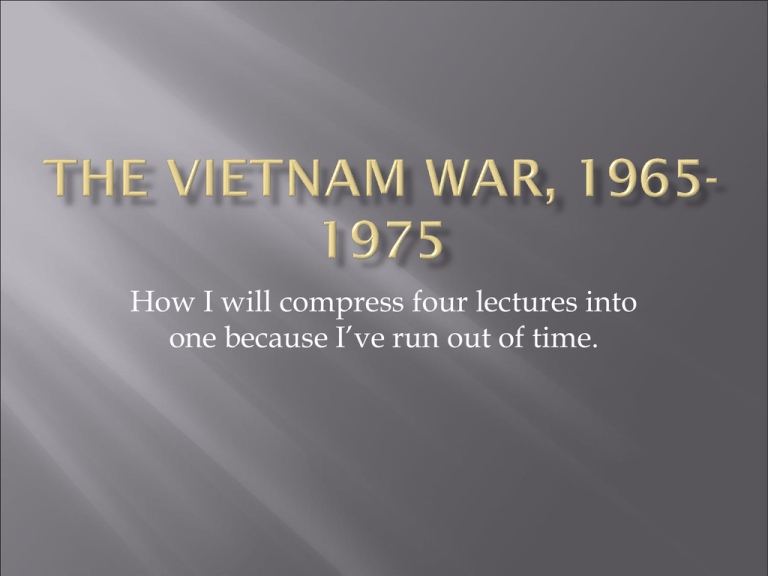
How I will compress four lectures into one because I’ve run out of time. A last-minute addition to my bibliography: • B.G. Burkett (Vanderbilt, 66) and Glenna Whitley, Stolen Valor: How the Vietnam Generation was robbed of its Heroes and its History (Dallas, 1998). • Burkett makes many claims in this book, but the most fascinating aspect of it is his exposure of the “phony Vietnam veteran,” a phenomenon that still amazes me. “Many Flags” campaign - Allied support 1.) South Korea – largest contingent – 48,000(would lose 4407 men)-US financial support 2.) Australia – 8000, lost 469 3.)New Zealand, 1000, lost 37 4.) Thailand – 12,000 troops, 351 lost 5.) Philippines – medical and small number of forces in pacification 6.) Nationalist China – covert operations American Force levels/casualties in Vietnam(K=killed W=wounded) 1964 1965 1966 1967 1968 1969 1970 1971 1972 23,200 190,000 390,000 500,000 535,000 475,000 334,000 140,000 50,000 K 147 W 522 K 1369 W 3308 5008 16,526 9377 32,370 14,589 46,797 9414 32,940 4221 15,211 1381 4767 300 587 Soviet and Chinese Support for North Vietnam • 1.) Despite Sino-Soviet dispute and outbreak of Cultural Revolution in China, support continues • 2.) Soviet supply of anti-aircraft technology and supplies to the North – along with medical supplies, arms, tanks, planes, helicopters, artillery, and other military equipment. Soviet ships provided intelligence on B-52 raids – 3000 soldiers in North Vietnam (Soviet govt. concealed extent of support) • 3.) Chinese supply of anti-aircraft units and engineering battalions – 327,000 troops sent – more than 17,000 killed 1.) 2.) Hawks – escalate the war Doves – a fractious coalition a.) Pacifists b.) New Left c.) Liberals (Robert Kennedy, George McGovern, Eugene McCarthy, Frank Church) 3.) Overall frustration within the country from lack of progress – demonstrations, civil disorders in the cities, inflation – support for the war drops to 40 percent Johnson’s Progress Offensive • 1.) Johnson’s November press Conference • 2.) Bringing Westmoreland home to report to Congress - “the end begins to come into view” • “the light at the end of the tunnel” • 3.) LBJ orders surveillance of the peace movement activities at home and abroad– Operation Chaos – dossiers on 7000 Americans – violation of CIA charter • 4.) Objective signs of progress – enemy suffering high casualties, problems with recruiting, ARVN desertion rate dropping, even McNamara believed progress was being made • 5.) PR campaign – “Committee for Peace and Freedom in Vietnam” – coordinated with the White House The Tet Offensive: The Eddie Adams Picture Beginning of the Offensive • 1.) Struck 36 of 44 provincial capitals, five of six major cities, 64 district capitals, and 50 hamlets • 2.) Raid on the US Embassy – got into the compound – lasted about six hours - all 19 killed or severely wounded • 3.) Also hit Saigon’s airport, presidential palace, and military headquarters • 4.) Most successful attack in Hue – held the city for a month • 5.) Siege at Khe Sanh – till April • 6.) overall enemy defeat – losses estimated at 40,000; weakening of the Viet Cong; North Vietnamese now assume most of the fighting Footage from Tet Offensive – CBS News http://www.youtube.com/watch?v=tm3Wimt tZjc&feature=related For the U.S. – A “Costly Victory” • 1.) US losses more than 1100, ARVN 2300 • 2.) More than 12, 500 civilians killed • 3.) Devastating Effect on American public opinion – 78 percent of Americans said no progress was being made; 26 percent approved Johnson’s handling of the war • 4.) Increase in the credibility gap – Tet seemed to show LBJ’s progress offensive was an exaggeration, to some a lie – Kennedy speech “Atmosphere of Gloom” • 1.) Robert Kennedy’s speech • 2.) Media reporting on the war – image of chaos and defeat • 3.) Walter Cronkite -YouTube - Walter Cronkite Remembers His Tet Offensive Editorial • 4.) NYTimes story – March 10, 1968 – Westmoreland’s request for 206,000 – produced an uproar 1.) Assassination of Martin Luther King in Memphis, April 1968 2.) Assassination of Robert Kennedy in June YouTube - Robert Kennedy's assasination 3.) Chicago Democratic convention – riots and protests YouTube - 1968 DNC: Democratic nightmare in Chicago Humphrey vs. Nixon vs. Wallace • http://www.livingroomcandidate.org/commer cials/1968 Nixon “Bring us together” Nixon and Kissinger 1.) Failure of linkage with Soviets, slow progress with China – the Korea parallel 2.) Secret bombing of Cambodia – “madman theory” 3.) Failure of negotiations with Hanoi ◦ Midway conference, Nixon Doctrine, Vietnamization, beginning of troop withdrawals 4.) Plans for Operation Duck Hook – “savage, punishing blows” The Frustrations of Vietnam, 1969 • 5.) Growth in antiwar sentiment – moratoriums of October and November 1969 – radicalization of part of the movement (Weather Underground, “Bring the War Home”) – Government response – COINTELPRO – covert efforts to infiltrate and discredit the movement • 6.) Nixon’s - Silent Majority Speech • 7.) Revelations of My Lai massacre – Nov. 1969 • 8.) First draft lottery – December 1969 The Frustrations of Vietnam, 1970 1.) Controversies over war in Laos, Feb. 1970 2.) Overthrow of Sihanouk, March 1970 3.) Announcement of withdrawal of 150,000 men, April 20, 1970 4.) “Incursion” into Cambodia – May 1970 – the search for COSVN 5.) Intense domestic reaction – Kent State 6.) US troop withdrawal from Cambodia, June 1970, but war continues 7.) 1970 midterm elections – Nixon’s defeat, fear of being one-term president The Agony of Vietnam - 1971 • 1.) Failure of Lam Son 371 – February 1971 – US supported – ARVN (South Vietnamese) invasion of Laos • 2.) April 1971 – Vietnam Veterans Against the War in Washington – John Kerry • 3.) Verdict in the Calley Trial – Public Outrage • 4.) The Pentagon Papers and Daniel Ellsberg – June 1971, Supreme Court Case against prior censorship Nixon and Kissinger – A Complex Relationship 1.) Kissinger as National Security Adviser – a constituency of one (Decent Interval http://web1.millercenter.org/dci/1970_1221_nixonwithdrawal.html 2.) Reassurances to Nixon – conversation April 1971 Nixon Tapes Transcript • Richard Nixon, Henry Kissinger • 4/7/1971 • 001-010 Nixon on Jews http://whitehousetapes.net/clips/1971_0705_jews/ Nixon on Diem http://tapes.millercenter.virginia.edu/clips/1971_0407_billygraham/main.swf 3.) Nixon as Strategist, Kissinger as Tactician? (April 14 conversation) China: http://nixontapes.org/hak.html 4.) Nixon on young people http://tapes.millercenter.virginia.edu/clips/nixon_students_1971_03_25.swf The Trifecta – Nixon’s Successes in 1972 – Determination to be the Peace Candidate • 1.) Opening to China – July 1971 – Trip February 1972 • 2.) Summit with Soviets – SALT I Agreement – May 1972 • 3.) Vietnam Peace Accords – announced October 1972, signed January 1973 • Result: Overwhelming Re-election, November 1972 The Decent Interval http://tapes.millercenter.virginia.edu/clips/19 72_0803_vietnam/ http://web1.millercenter.org/dci/1972_1006_t hieu.html McGovern’s Campaign – Come Home, America October Surprise – “Peace is at Hand” (Kissinger and Le Duc Tho) Impact on the election • Chapter II - Memoirs V. Tapes: President Nixon & the December Bombings • “wiped McGovern out now” Nixon Landslide – 1968 vs. 1972 Christmas Bombing of 1972 Paris Peace Accords of January 1973 • 1.) North Vietnamese troops allowed to remain in the South • 2.) US troops withdrawn • 3.) US POWs returned • 4.) Thieu remains in power • (Nixon’s secret/public assurances) Watergate Nixon’s Resignation – August 1974 Fall of Saigon – April 1975 Vietnam – Reeducation camps • 1.) 500,000 to 1 million in camps (out of population of 20 million) – death toll uncertain – Killing Fields of Cambodia Why the collapse? • 1.) Nixon’s resignation; Watergate’s effect on presidential authority • 2.) Congressional cutbacks in aid to South Vietnam – refusal to pass emergency legislation • 3.) South Vietnamese weakness, disunity, poor strategic decisions • 4.) Cambodia – weakness and corruption of government; displacement through bombing; sideshow of Vietnam, as with Laos Subsequent Events, 1975-2011 • 1.) Vietnam officially reunifies 1976 – Southerners pushed aside; Khmer Rouge pursues genocide in Cambodia • 2.) Vietnam invades Cambodia and topples Khmer Rouge government, December 1978 – continuing guerilla war • 3.) China attacks Vietnam January 1979 – fights for two months in North Vietnam and withdraws • 4.) Vietnam becomes Soviet ally – US demands accounting of POWs and MIAs – exodus of the “boat people” estimates between 1 to 1.5 million • 5.) Vietnam adopts economic reforms “doi moi” in 1986 – loses aid with collapse of Soviet Union and Eastern bloc 1989-1991 • 6.) US and Vietnam restore diplomatic relations in 1995 • 7.) Cambodian civil war ends, 1998 • 8.) Clinton visits Vietnam, November 2000 – US largest trade partner, de facto military alliance despite human rights concerns A Historian’s Perspective - George Herring on Lessons of Vietnam • 1.) Centrality of local forces as opposed to international politics • 2.) Limits of Power – the “poisonous tangle of local politics” • 3.) Need for debate and discussion about foreign policy • Problems with all three “lessons” Vietnam and Iraq and Afghanistan • 1.) Problems of local forces vs. global network • 2.) Effectiveness of counterinsurgency • 3.) US public opinion and the political dynamics of war • 4.) Role of the US in the World – the Wilsonian temptation

